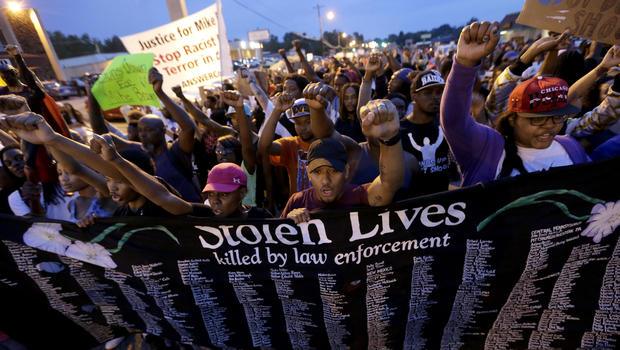Statistically, New York police shoot more often at blacks than at whites–by about 700 percent. But, statistically blacks are armed and shoot at police more often than whites–by over 700 percent, according to national statistics and the NYPD’s annual firearms discharge report. In light of the recent “Black Lives Matter” protests in New York following the decision not to indict white NYPD officer Daniel Pantaleo for the death of unarmed black New Yorker Eric Garner, some experts have been dismayed by current popular misunderstandings and misrepresentations, as well as by the creation of what they call a “moral panic” about policing in the US.
“Nobody is in denial here that there is a racial problem in America–however, pining the problem on the police profession, in general, and police officers specifically will lead to an even greater divide and injustice and, furthermore, will weaken and eventually collapse our democracy,” Dr. Maria Maki Haberfeld, professor and chairperson at New York’s John Jay College of Criminal Justice, told The Speaker.

“I have written about this extensively, over the years, and I am beyond depressed with what is happening right now.
“[The] stats seems to be reflective of what is indeed the situation in the country and reflect, to a high degree, what we refer to as the ‘Moral Panic Theory,’ when the general public, fed by the media coverage of some exaggerated and/or misleading accounts, where the impression is that ‘Black lives do not matter’ responds to this mantra without posing for a moment to look at the numbers and realize that black lives indeed do matter to the police departments and police officers around the country, yet they appear not to matter to the black population itself.”
Haberfeld qualified that her comments related to the statistics and the numbers and that she made no judgments specifically about the two most recent cases of Mr. Brown and Mr. Garner. She was, she said, “responding to the moral panic rhetoric that claims that these two incidents are representative of policing in the US.”
According to a joint national investigation of police shootings that resulted in death, almost 10,000 people were killed by police fire in a recent 25-year period--a statistic, Haberfeld pointed out, puts the recent deaths in perspective.
“We have around 18,000 police departments in this country and close to 800,000 armed police officers, so statistically speaking you also have something here that doesn’t show a trend of “trigger happy” officers.”
Considering that an average of 18,000 people are killed in the US per year, the 10,000 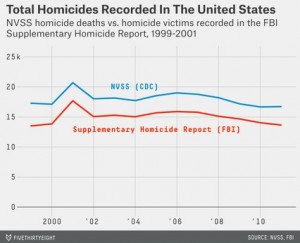 deaths represent around two percent of the approximately 450,000 homicides that took place during that period.
deaths represent around two percent of the approximately 450,000 homicides that took place during that period.
Haberfeld noted that the context in which police shootings take place was also important when considering shooting deaths.
“If somebody threatened to kill their spouse, for example, and was killed by a police officer–then this killing is not something that can be understood from the perspective of sheer number, it was a justified killing, so, I would rather comment about how many unjustified killings were there and still, some will always feel that all the killings by the police are unjustified.”
It has also been found that in major US cities, blacks are overrepresented among police shootings–particularly in New York, San Diego and Las Vegas.
New York is America’s largest police authority by far, policing over 9 million people with around 35,000 officers.
According to the NYPD’s Annual Firearms Discharge Report, the most recent of which is for 2012, blacks killed by police equates roughly with the incidence of armed blacks encountered by police and with the incidence of blacks shooting at police.
Most of the officers who discharged their firearms were white (53 percent), followed by hispanic (32 percent) and black (12 percent). The 53 percent for whites was roughly on par with their percentage in the department (52 percent). Blacks were slightly
underrepresented–16 percent of staff but only 12 percent of shootings. Hispanics were slightly overrepresented in 2012–26 percent of staff, but 32 percent of shootings.
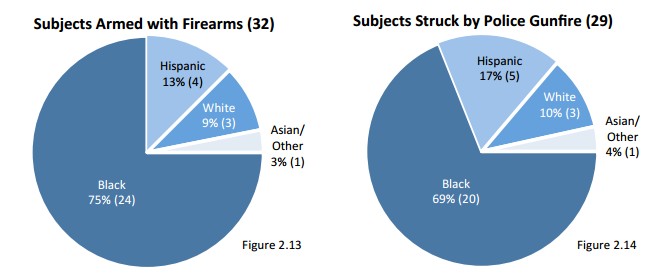 NYPD records showed that of armed civilians encountered by police in 2012, 75 percent were black. 13 percent were hispanic and 9 percent were white.
NYPD records showed that of armed civilians encountered by police in 2012, 75 percent were black. 13 percent were hispanic and 9 percent were white.
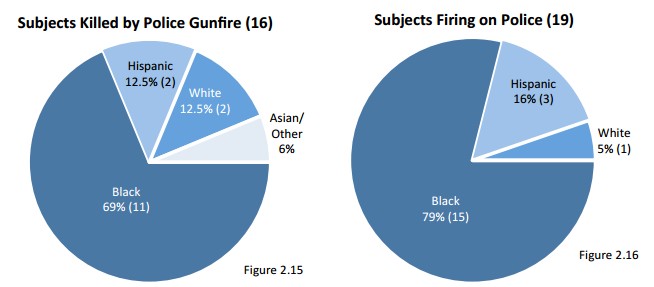 Of civilians who fired at police, 79 percent were black, 16 percent were hispanic and 5 percent white.
Of civilians who fired at police, 79 percent were black, 16 percent were hispanic and 5 percent white.
This marked an increase in armed blacks from 2011 when 56 percent of adversarial conflicts involved am armed black civilian. Armed Hispanics accounted for 30 percent and whites 15 percent in 2011. Of those who actually shot and hit a police officer, 43 percent were black, 36 percent were Hispanic and 21 percent white.
The yearly report also found that blacks were the race most frequently shot at by police, with roughly similar figures.
Of those shot at by police, 69 percent were black, 17 percent Hispanic and 10 percent were white. Sixty-nine percent of those killed by police were black, while Hispanics and whites each made up 12.5 percent of the picture.
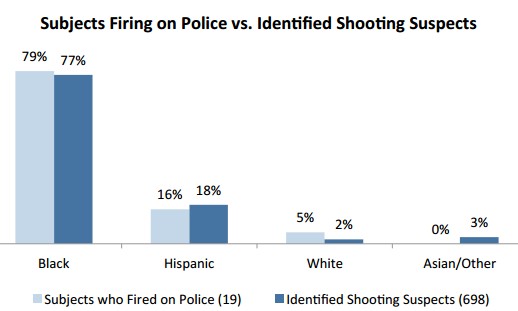 The report found that of approximately 35,000 uniformed officers employed by the NYPD, who responded to approximately five million calls–250,000 of which involved weapons, 60 officers (or 0.17 percent) intentionally fired their weapon at a civilian. Meanwhile, officers made 26,091 weapons arrests that included 6,000 gun arrests. Over 26,000 of the 26,091 weapons arrests were completed without an officer firing his or her weapon.
The report found that of approximately 35,000 uniformed officers employed by the NYPD, who responded to approximately five million calls–250,000 of which involved weapons, 60 officers (or 0.17 percent) intentionally fired their weapon at a civilian. Meanwhile, officers made 26,091 weapons arrests that included 6,000 gun arrests. Over 26,000 of the 26,091 weapons arrests were completed without an officer firing his or her weapon.
In the past 15 years, NYPD shootings have resulted in 179 deaths. In other words, 179 people were killed by Npolice while on duty out of 75 million calls.
“Again statistically speaking this is not a significant number,” commented Haberfeld, “given the fact that many of these shootings were justified because the people who were shot were armed and dangerous.”
Blacks are also more frequently encountered by police answering calls with regards to violent crime. Nationwide, blacks are over 700 percent as likely to commit violent crimes than whites, and when they do, they are almost three times more likely than non-Blacks to use a gun and over twice as likely to use a knife. The victims of violent crimes committed by blacks are usually white (45 percent), which is significantly higher than the victims of violent crimes committed by whites. Only three percent of criminal violence by whites is directed at blacks. In other words, blacks are around 39 times as likely to commit a violent crime against a white person than vice versa.
The trend is a little different when murder is at issue, however. Unlike violent crime in general, homicides are most frequently committed by and against a person of the same race, with black on white being only a few percent more common than white on black homicide.
Recently, former New York City mayor Rudy Giuliani commented on the recent police shooting deaths in New York and referenced the statistic that, “Ninety-three percent of blacks in America are killed by other blacks. We’re talking about the exception here.”
From 1980 to 2008, 94 percent of black homicide victims were killed by blacks, and 84 percent of white victims were killed by whites.
Statistically. the main killer of blacks when it comes to violent deaths is other blacks. US-wide, around 8,000 blacks were killed every year between 1976 and 2011, and 94 percent of those were killed by other blacks. Of those 8,000 around 2.8 percent were killed by police.
“The overwhelming majority of black victims are killed by black perpetrators and NOT the police,” noted Haberfeld.
In St Louis, which has experienced prolonged demonstrations and riot over the past months in the wake of the shooting death of teenager Michael Brown, just under two percent of the 1,265 murder victims between 2003 and 2012 were attributed to police, while 90 percent of the deaths–1,138 killings–were attributed to black civilians.
Blacks, however, have been found to perceive that police are targeting them based on race. A Pew study last year found that 70 percent of blacks feel that police treat whites better. Thirty-seven percent of whites agreed.
The sentiment that police target blacks has been given voice recently by US President Barack Obama and other politicians and public figures. This month, Obama said that blacks’ distrust of police was “rooted in realities” and that the black reaction to the verdict was “an understandable reaction.” The sheer numbers of black deaths was highlighted by liberal black professor and author Marc Lamont Hill in a recent debate, who stated, “Every 28 hours. Every 28 hours, Larry. Larry, every 28 hours. According to the MXGM study, a black person is killed by law enforcement, vigilantes or security…”
The perceptions of blacks and police statistics clash strongly however, as, in addition to bare facts about deaths of blacks by police fire, police are also less ready to shoot at blacks than at whites, according to a recent Washington State University study–participants were found to shoot unarmed whites around 25 times more readily than unarmed blacks.
Haberfeld stated that she did not feel that numbers would provide the whole picture, however.
“In general, I believe that police work cannot be simply understood by the analysis of sheer numbers.”
“As to what I think the public needs to understand about policing? Well, first and foremost the fact that police organizations are political entities that operate based on what the local, state or federal politicians mandate them to do. I can assure you that no police chief or commissioner comes up with his/her own operational priorities, without having them approved or, to begin with, designed by the politicians–a Mayor for the local, municipal forces, Governor for the State Police and the President for the Federal law enforcement agencies.
“So, if certain groups within the public feel that there is something profoundly wrong with the way police agencies operate then they should direct their anger at the politicians and demand their resignation or change of whatever it is they feel that is wrong, be it recruitment, selection, training, supervision and discipline of police officers.”
